Key Master Calligraphers
Ibn Muqla | Ibn al-Bawwab | Yaqut al-Musta‘simi | Mir ‘Ali Tabrizi | Mir ‘Imad al-Hasani | Seyh Hamdullah | Hafiz Osman | Hasan Çelebi | Mohamed Zakariya
Ibn Muqla (885-940 A.D.)
Full name:
- Abu ‘Ali Muhammad Ibn ‘Ali, known as Ibn Muqla (“Son of Muqla”)
What he did:
- Codified the six scripts (al aqlam al-sitta) that became the foundation for the practice of calligraphy to come
- Established a proportional writing system that used a circle with the diameter of the letter alif as its basis
- Wrote extensively about the art of calligraphy and devised theories of letter shapes
Biography:
- Born in Baghdad
- Became a scribe in the administration of the ‘Abbasid caliphate (750-1258)
- Became head of the state library
- Was made vizier (chief counselor) three times between 928 and 936, all under different rulers
- Was imprisoned three times during periods of political turmoil
- During one imprisonment, his enemies cut off his right hand. When released, he continued to work with great skill using his left hand
- Finally, his left hand was severed, his tongue cut out, and he was cast into prison where he died
Ibn Muqla’s proportional writing system

The six scripts

Ibn al-Bawwab (late 10th century-1022 A.D.)
Full name:
- Abu’l-Hasan ‘Ali Ibn Hilal, known as Ibn al-Bawwab (“Son of the Doorman”)
What he did:
- Refined the rules of Ibn Muqla’s six scripts
- Developed a system of proportional measurement such that each letter could be measured by its height and width in dots
Biography:
- Born a commoner, the son of a doorkeeper
- Began his career as a house painter, then became a book illuminator
- Took up calligraphy, mastered the known calligraphy scripts, and developed a few new scripts
- Was an imam in a mosque in Baghdad
- Was a bit eccentric and wore odd clothes
- Wrote a famous poem about calligraphy (see right)
- Wrote 64 copies of the Qur’an, only one of which still exists (in Dublin’s Chester Beatty Library)
Proportional writing system using dots
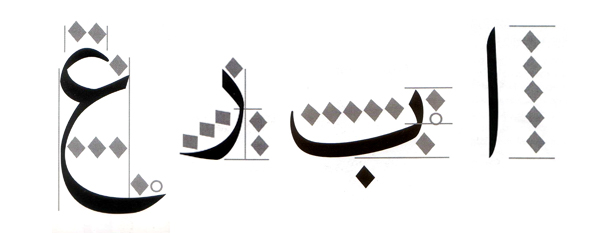
Excerpts from a poem on calligraphy
In the name of God, the
merciful, the compassionate.
To him is the voyage and the
return.
O you who seek perfection of
writing and desire beautiful
calligraphy and forms,
If your dedication to writing is
true, then be pleased that
your Lord has made it easy.
Learn all the pens [styles], each
one treasured and lively, that
make the inky art like the
jeweler’s craft. […]
Don’t be ashamed by the
ugliness you will write in the
first stages of your practice,
Because the job will be hard,
then easy. How often ease
comes after distress.
When you have reached the
goal you desired and you are
pleased and happy,
Thank your God and follow his
desires. God loves the
thankful.
Be pleased with your hand,
whose fingers write so well,
leaving beautiful works
behind in the abode of
illusion. […]
Yaqut al-Musta‘simi (early 13th century-1298 A.D.)
Full name:
- Abu’l-Majd Jamal al-Din Yaqut, known as Yaqut al-Musta‘simi because he served Caliph al-Musta‘sim
What he did:
- Refined the six scripts set down by Ibn al-Bawwab
- Gave the letter shapes new dimension by emphasizing the slanted cut of the pen
- Further systematized the method of proportional measurement with dots
- Developed the school of calligraphy that Turkish and Persian calligraphers followed for years to come
Biography:
- Born in the region of Anatolia
- Was a slave of the last caliph of the ‘Abassid dynasty in Baghdad, al-Musta‘sim Billah (reigned 1242-1258)
- Spent nearly his whole life in Baghdad
- Became a scribe in the royal court
- Studied calligraphy with an excellent woman calligrapher named Shuhda Bint Al-‘Ibari, a student in the direct line of Ibn al-Bawwab
- Committed to his work. During the Mongol sack of Baghdad in 1258, he took refuge in the minaret of a mosque so he could finish his calligraphy practice, while the city was being ravaged below
- His career flourished under Mongol patronage
- Wrote prolifically. Made 364 copies of the Qur’an, several copies of which still exist and are highly prized by collectors
Slanted cut of the pen

Proportional measurement system

Calligraphy attributed to Yaqut al-Musta’simi
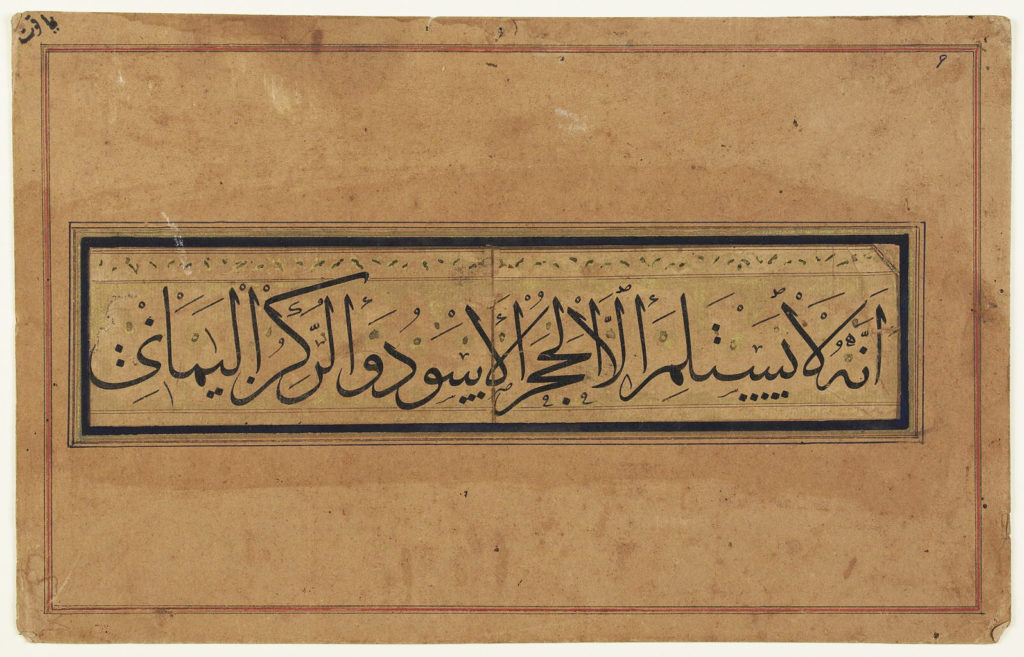
Mir ‘Ali Tabrizi (1360-1420 A.D.)
Full name:
- Mir ‘Ali ibn Hasan al-Sultani, known as Mir ‘Ali Tabrizi because he lived most of his life in the city of Tabriz
What he did:
- Codified the nast‘aliq script, which became the most important script in Persian calligraphy
Biography:
- Little is known about his life except that he lived in Tabriz (Persia) and was a poet and calligrapher
- He is called “the chief of the scribes” because of his work in developing the nasta‘liq script
- Tradition says that, after dreaming one night about geese, Mir ‘Ali adapted the shape and motion of their wings into visual form, creating the nasta‘liq script
Calligraphy attributed to Mir ‘Ali Tabrizi
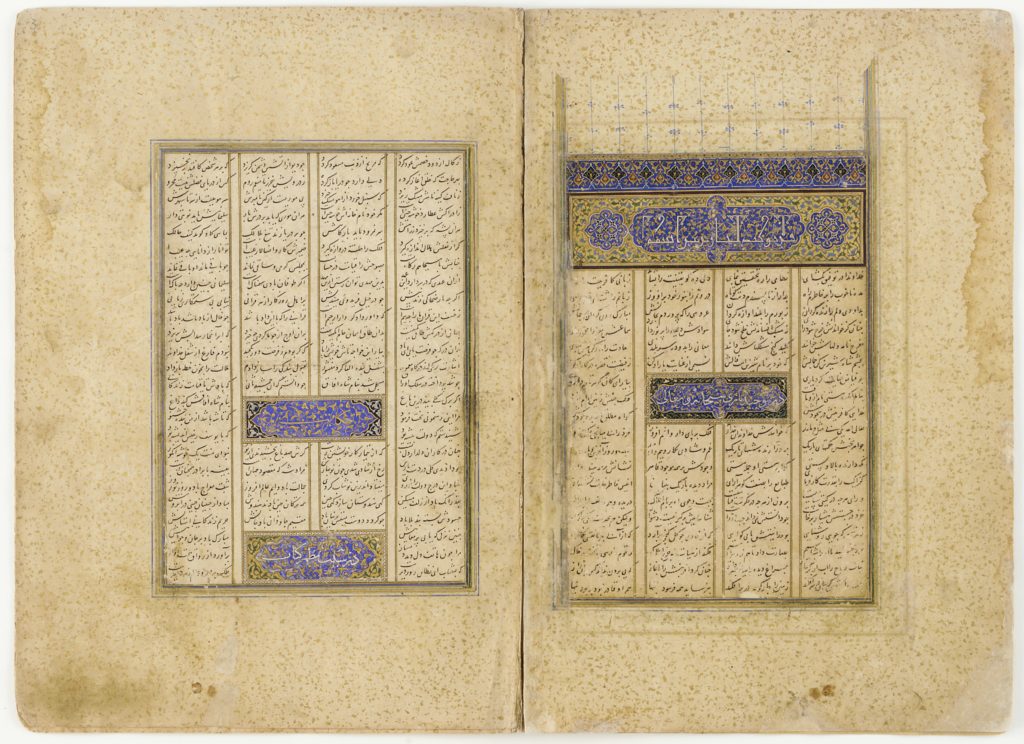
Mir ‘Imad al-Hasani (1554-1615 A.D.)
Full name:
- ‘Imad al-Mulk Muhammad ibn Husayn Muhammad Shafi’al-Hasani al-Sayfi al-Qazvini, known as Mir ‘Imad al-Hasani for short
What he did:
- Many scholars and calligraphers consider him the finest writer of the nasta‘liq script
Biography:
- Worked in the court of Safavid Shah ‘Abbas I (reigned 1587-1629)
- Chief rival of ‘Ali Riza ‘Abbasi, a designer of calligraphy inscriptions
- Murdered in a conspiracy involving a jealous rival and vain monarch
- His work was immensely popular during his lifetime and after his death
Calligraphy by Mir ‘Imad al-Hasani
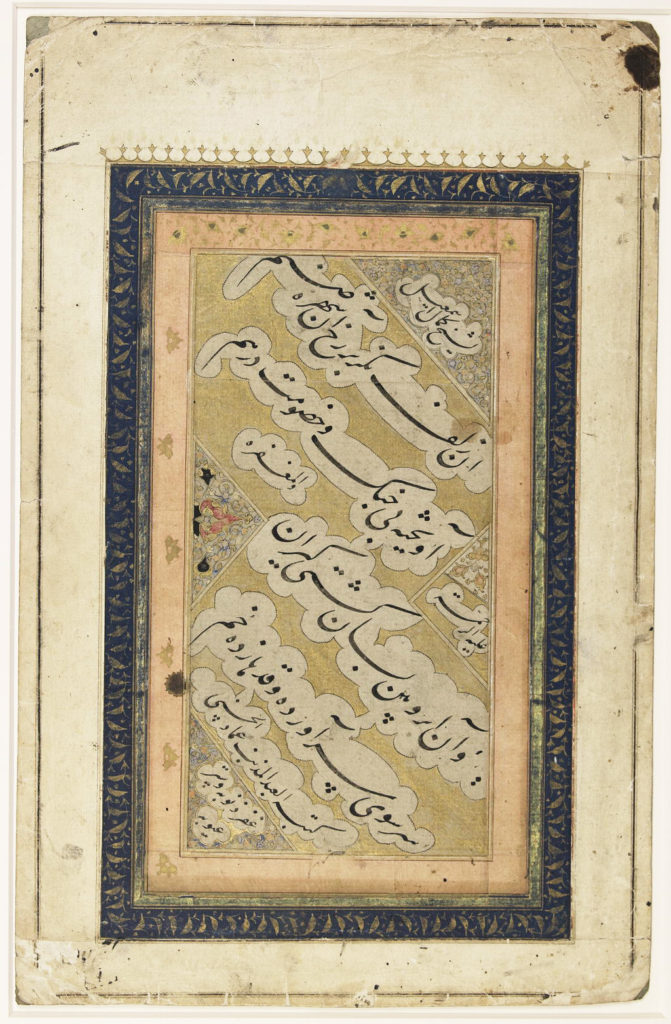
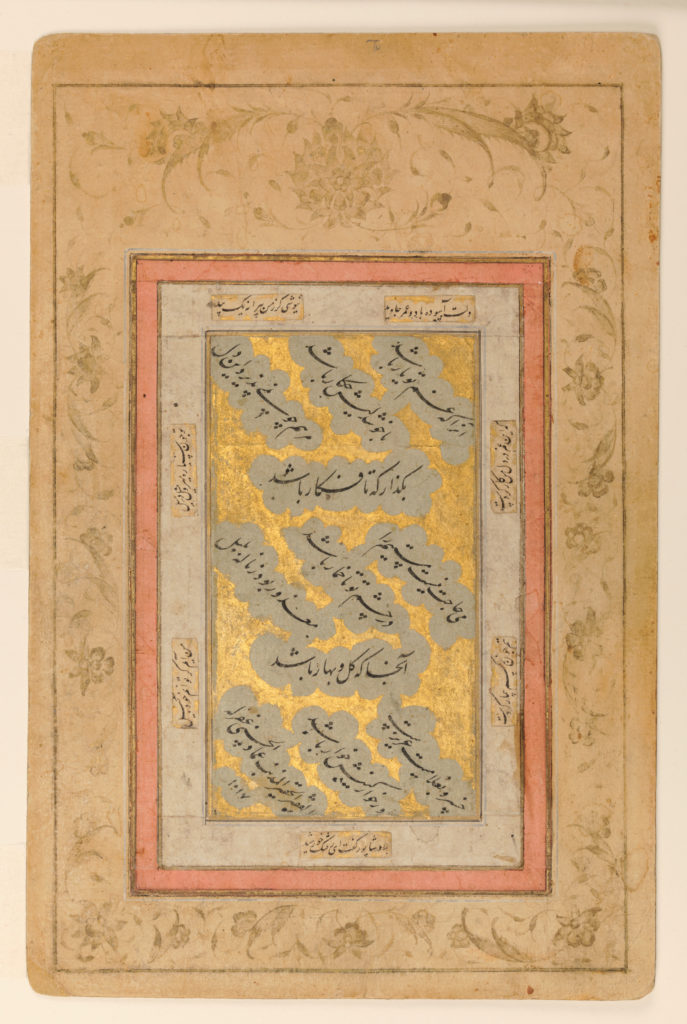
Seyh Hamdullah (1436-1520 A.D.)
Full name:
- Hamd Allah al-Amasi, known as Şeyh Hamdullah (Şeyh is the Turkish word for sheikh)
What he did:
- Founder of modern Turkish calligraphy
- Refined the six standard scripts, and was highly esteemed for his writing in the naskh and thuluth scripts (he followed the tradition of Yaqut al Musta‘simi)
Biography:
- Born in the region of northern Anatolia
- Member of a dervish order
- Studied calligraphy under the master Hayreddin Mar‘asi
- When his calligraphy student Bayezid II became sultan in 1481, Hamdullah became a member of the royal court
- The sultan so respected Hamdullah that he held the calligrapher’s inkwell while he wrote
- When Bayezid II died, Hamdullah fell into disfavor and retired to the country
- Wrote 47 copies of the Qur’an, several of which still exist in the Topkapi Palace Museum Library in Istanbul
Calligraphy by Şeyh Hamdullah
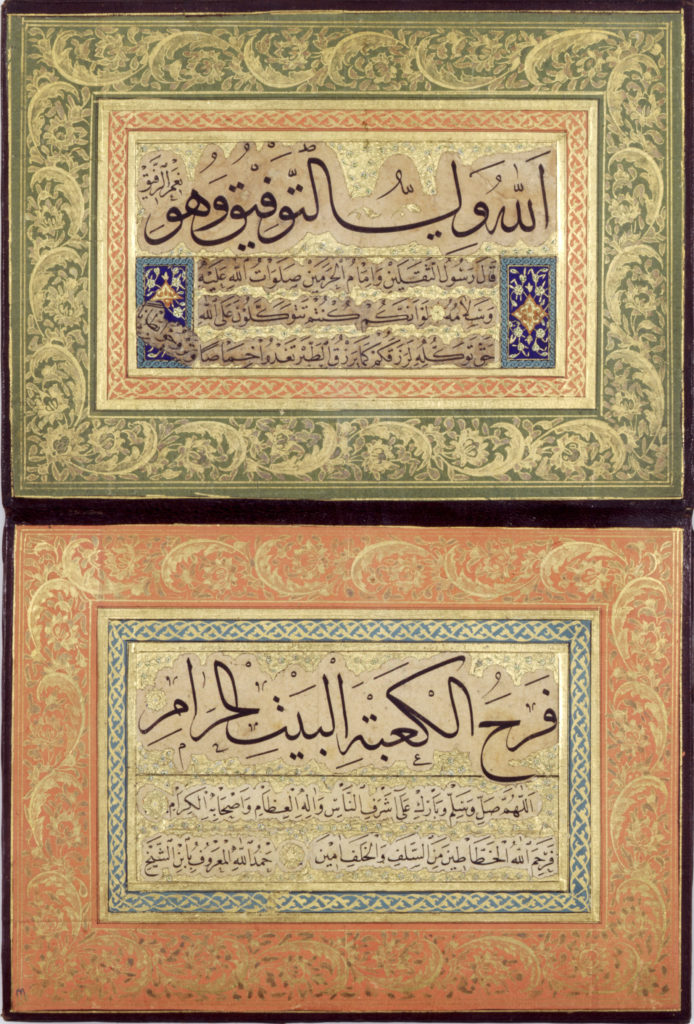

Apart from the obvious beauty of Ottoman calligraphy, what appeals to me is the important relationship between master and apprentice, and the infinite capacity of this art to renew itself from one generation to the next.
Sakıp Sabancı, Turkish philanthropist
Hafiz Osman (1642-1698 A.D.)
Full name:
- Hafiz Osman
What he did:
- Considered the greatest 17th century calligrapher of the Ottoman style
- Re-invigorated the tradition of Seyh Hamdullah, and re-introduced the six scripts that had fallen into disuse
- His style slowly replaced Seyh Hamdullah’s
Biography:
- Member of a dervish order
- Famous for his writing in the naskh script
- Tutored sultans Ahmed II (died 1691), Mustafa II (died 1695) and Ahmed III (died 1736)
- Sultan Mustafa II respected the calligrapher by holding his inkwell while he wrote
- Wrote 25 copies of the Qur’an. Examples of his work are held at the Topkapi Palace Museum Library in Istanbul and by the Nasser D. Khalili Collection
Calligraphy by Hafiz Osman
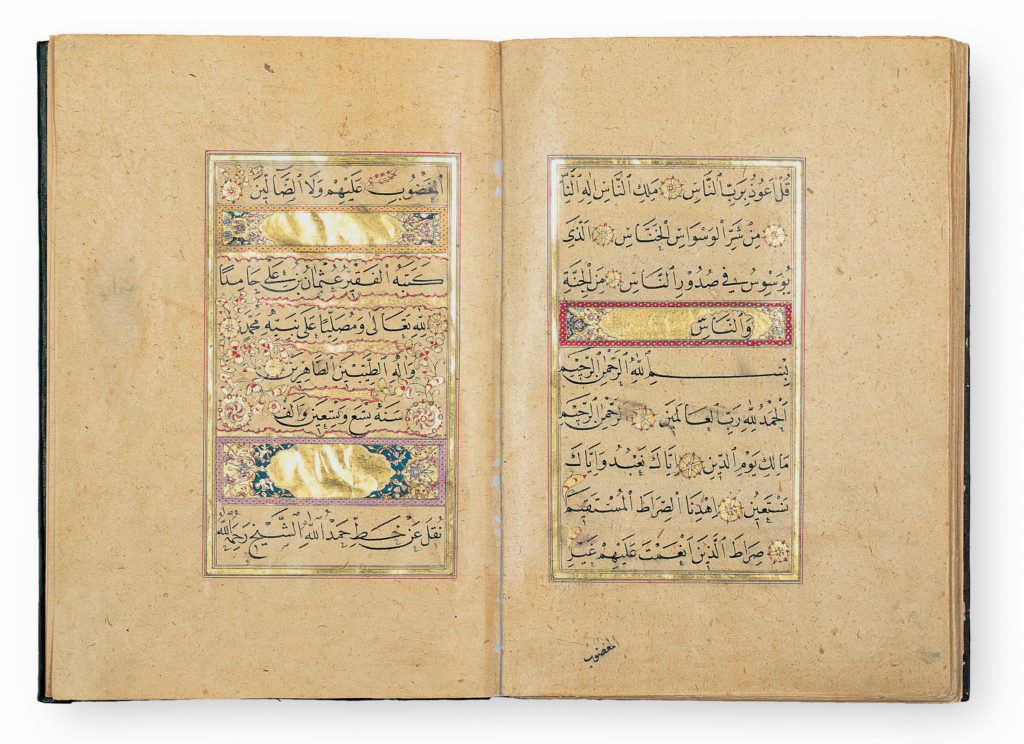
Hasan Celebi (1937-present)
Full name:
- Hasan Çelebi
What he did:
- Refined the rules of Ibn Muqla’s six scripts
- Developed a system of proportional measurement such that each letter could be measured by its height and width in dots
Biography:
- Internationally-recognized calligraphy artist in the Ottoman tradition
- Served as an imam until 1987
- Teaches hundreds of students, 30 of whom have received a certificate or license (ijaza)
The first requirement is to love the art. Love comes before skill. If someone doesn’t desire khatt [calligraphy] they will not succeed. Today, I can’t write the Latin alphabet as my hand shakes too much. When I try to read a book, I can’t read more than 15 pages without falling asleep. But with khatt, my hand stays steady and there are times when I can study the art ten hours or more without lifting my head. Because I love it. It is also necessary to have patience, a good teaching and a good working environment. It is important to be writing everyday, especially when you’re a beginner. I tell my students they must put in 30 hours a day!
Hasan Çelebi
Hasan Çelebi
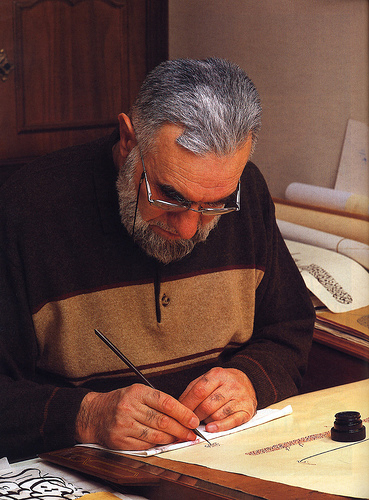
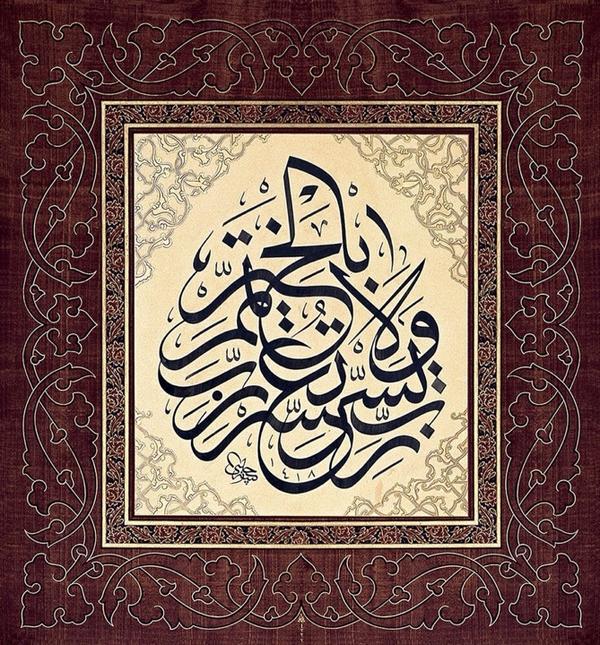
Calligraphy by Hasan Çelebi
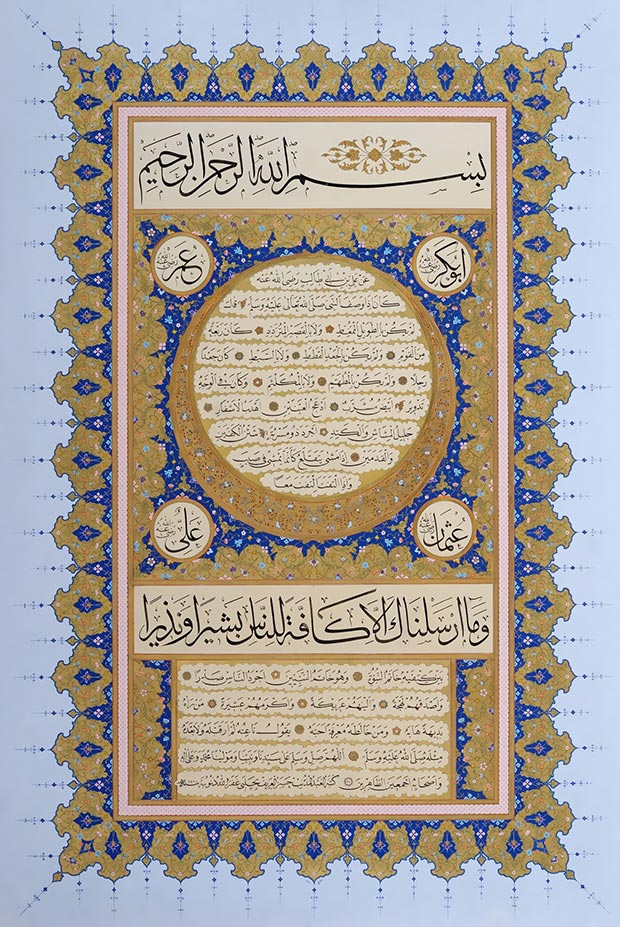
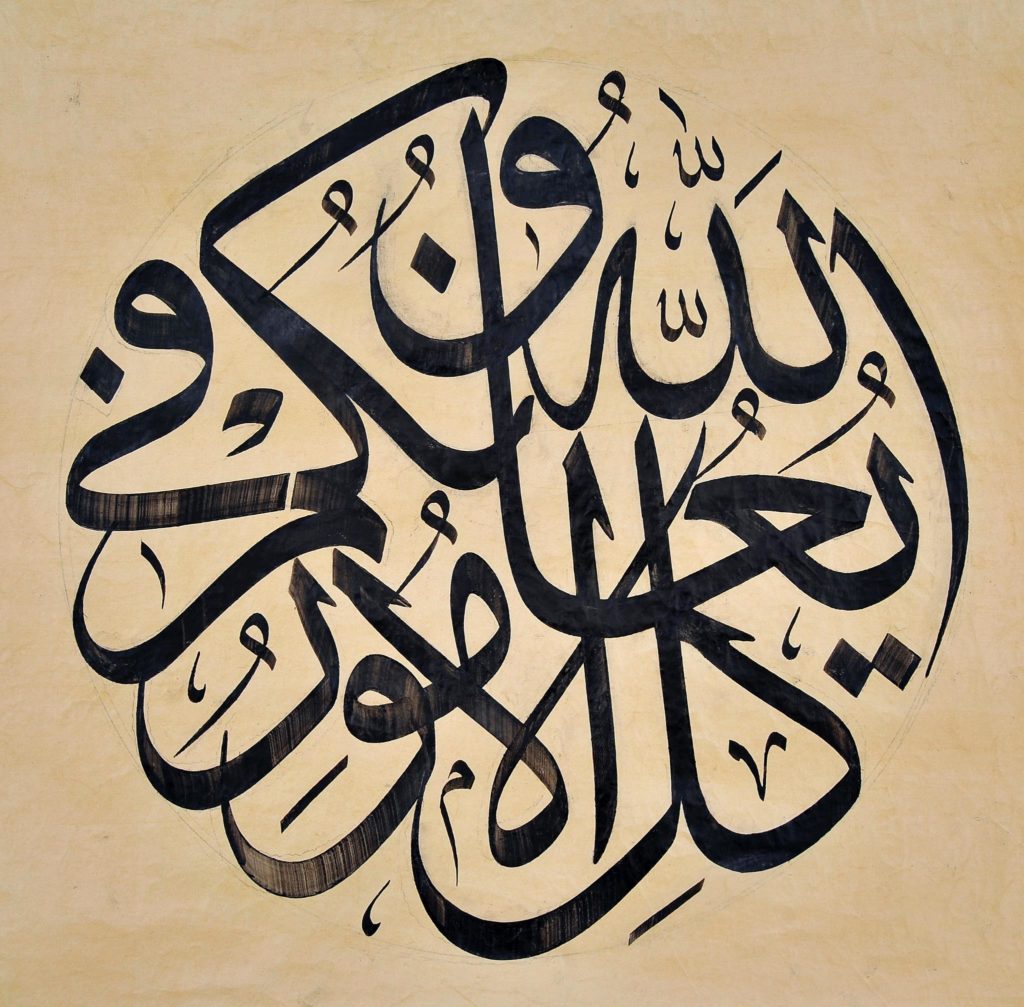
Mohamed Zakariya (1942-present)
Full name:
- Mohamed Zakariya
What he did:
- Became an American master calligrapher after studying with Hasan Celebi
- Commissed to create the U.S. Eid postage stamp
- Leading proponent of Islamic calligraphy in the United States today
Biography:
- Grew up in California
- Converted to Islam after traveling in the Middle East
- Master woodworker, engraver, machinist and maker of scientific instruments
- Studied with several Turkish calligraphy masters and received his ijaza in 1988 for the thuluth and naskh scripts, and in 1997 for the ta‘liq script (a Turkish variant of nasta‘liq)
- Teaches, lectures and exhibits his work internationally
- Website: https://mohamedzakariya.org/
Mohamed Zakariya
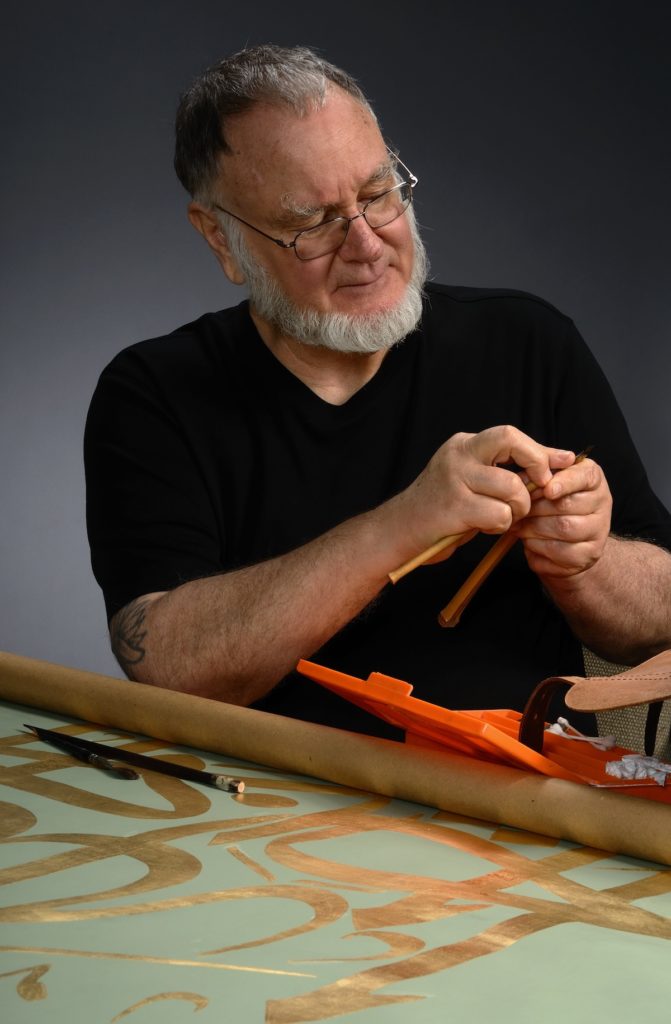
Calligraphy by Mohamed Zakariya
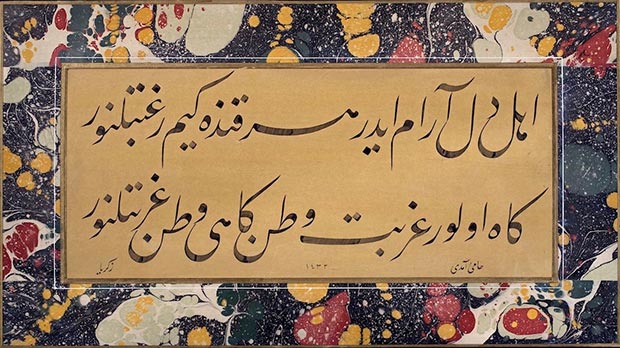

To learn more about Mohamed Zakariya, watch the documentary by Sanaa Boutayeb Naim, Music of the Eye.
Sometimes people ask me, ‘What does it feel like to do such work?’ There is no good answer, except awareness of the standards that have been set for the art and the responsibility to be faithful to them. So, rather than think of myself as a calligrapher, I still think of myself as becoming a calligrapher.
Mohamed Zakariya. Becoming a Calligrapher: Memoirs of an American Student of Calligraphy.